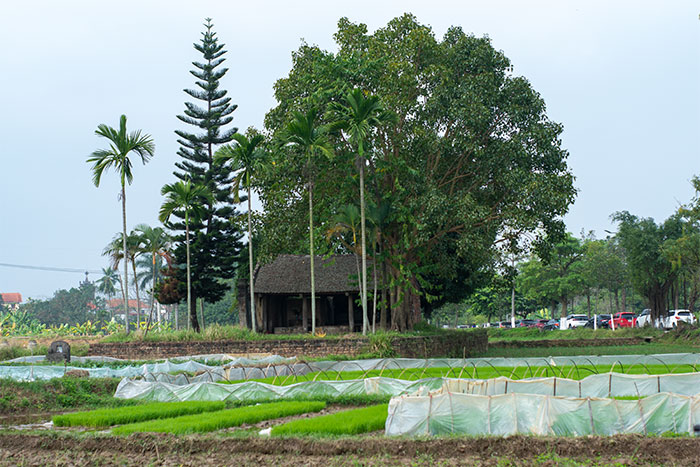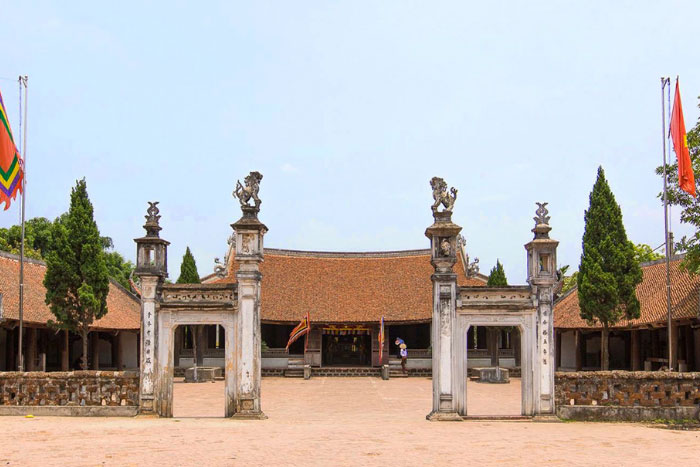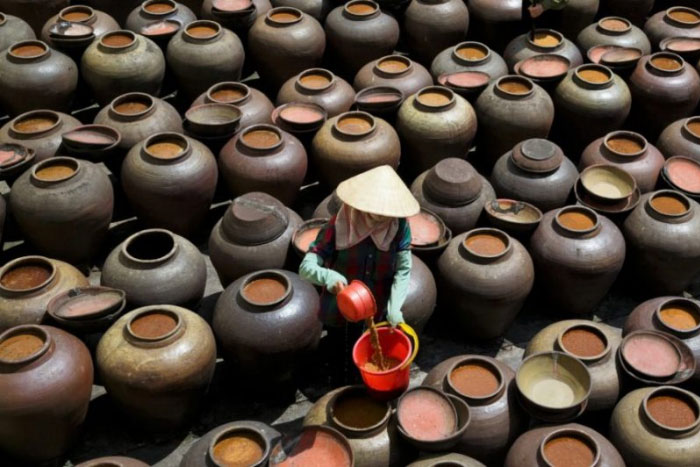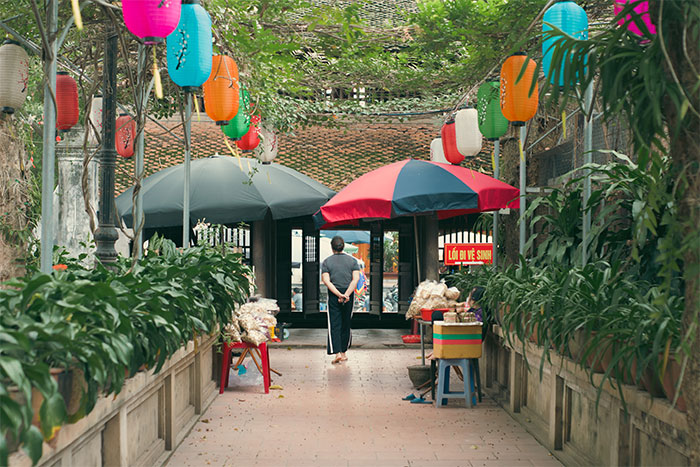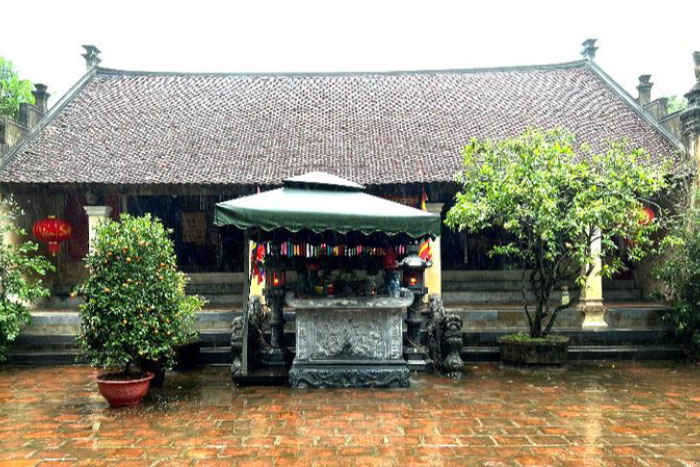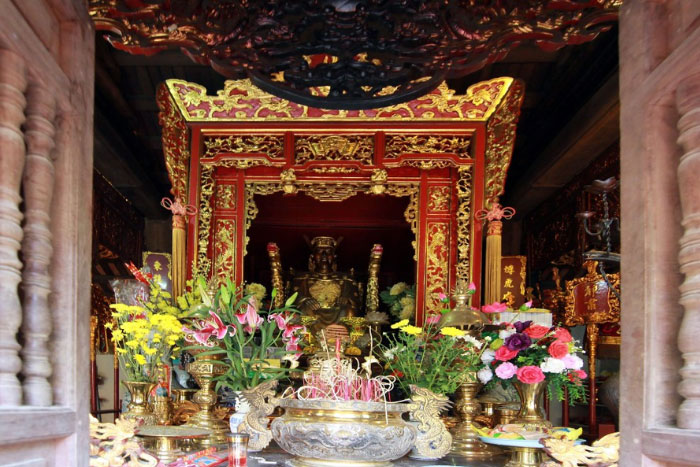
Having a week-end in Hanoi and having nothing to do ? Worry not, this blog is exactly for you. One whole day in Duong Lam village should be a wonderful experience for you. Take a look at what you can do in this ancient village in Hanoi.
1. Where is Duong Lam village ?
Nestled about 45 kilometers to the west of bustling downtown Hanoi lies a hidden gem: Duong Lam Village. Tucked away in Son Tay Town, this quaint village is a treasure trove of history and culture waiting to be explored. Wander its cobblestone streets, and you'll find yourself transported back in time, surrounded by 956 ancient houses, some dating as far back as the 17th century.
Amongst the countless villages scattered across Vietnam, Duong Lam Village holds a special distinction. It proudly stands as the first to be recognized as a national-level artistic site of architecture. With its rich heritage and captivating charm, Village Duong Lam is more than just a village—it's a living testament to Vietnam's vibrant past and enduring traditions.
2. What to do in Duong Lam ?
Being one of the most famous ancient villages in all of Vietnam, Duong Lam Village holds much to offer to you - the visitors. So below are places and activities we would recommend to do and see for yourself !
a. The communal home Mong Phu
Step into the rich tapestry of history and culture as we explore the Mông Phụ communal house in the charming village Đường Lâm. Nestled amidst the tranquil landscapes, this architectural gem stands tall on the central and highest land of the village, spanning an impressive 1,800 square meters. Dating back to 1533, during the reign of King Mạc Đăng Doanh, the communal house has witnessed centuries of change and preservation. Despite several renovations and repairs, its original architectural splendor from the early 19th century remains intact. Notably, in 1858, under the reign of King Tự Đức, the communal house underwent its first major repair, marking a significant chapter in its storied history.
Today, the communal house boasts a distinctive "Công" (工) shape, comprising the main gate (Nghi môn), courtyard, Left and Right Mac Houses (Tả Mạc and Hữu Mạc), and the grand Main Hall. Additionally, outside the main structure lies the Rear Courtyard House (Nhà Xích Hậu), serving as a welcoming space for guests and ceremonial preparations. As you enter through the majestic main gate, you'll be greeted by four square pillars adorned with intricate carvings and embossed images of sacred animals. The spacious courtyard, paved with traditional Bát Tràng bricks, leads to the Left and Right Mac Houses, where ancestral worship and homage to village contributors take place.
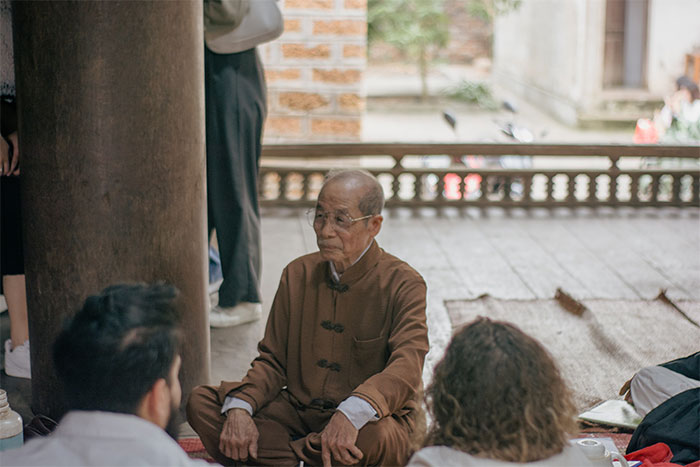
The Main Hall, a testament to exquisite craftsmanship, features five compartments and two roofs, with a back hall extending like a graceful pestle. Two ancient wells, known as the "two dragon eyes," flank the communal house, adding to its mystical allure. The roof, resembling a light canopy, is adorned with dragon motifs and intricate carvings, while the interior showcases a large altar adorned with symbolic dragon and tiger statues. Within the sacred halls of the communal house, the deity Tản Viên Sơn Thánh (Tản Viên Mountain Saint) is worshiped, embodying the village's protector and spiritual guardian. Treasures such as ancient steles and ornate lacquered boards bear testament to the communal house's cultural significance and reverence.
Recognized as a national historical and cultural relic since 1984, the Mông Phụ communal house stands as a beacon of heritage and tradition, inviting visitors to immerse themselves in its timeless splendor. Embark on a journey through time and discover the soul-stirring beauty of Đường Lâm's architectural masterpiece.
b. The making of Tuong
In every household, you'll find a few prized jars of Tuong, lovingly prepared to last the year or offered to guests from distant lands. Today, amidst the rustic charm of Mong Phu village, some families continue the legacy of crafting the region's signature sticky rice Tuong, a delicacy revered for its unique flavor profile. Crafting the perfect Tuong is no small feat—it requires dedication, attention to detail, and a touch of old-world charm. This centuries-old tradition is a labor of love, carried out entirely by hand without the aid of modern machinery.
The process begins in the warm months of May to July, when the sun's rays are plentiful, ideal for fermenting and maturing soybeans. Using locally sourced ingredients like glutinous rice, soybeans, corn, and salt, artisans set out to create a rich and flavorful brew that captures the essence of the land. Selecting the finest grains of glutinous rice, artisans ensure only the best quality is used, allowing it to ferment and develop a greenish hue—a sign of its readiness. Meanwhile, soybeans are meticulously roasted to perfection, infusing them with a fragrant aroma and a beautiful golden hue.
Once the rice and soybeans are prepared, they're ground into small pieces and left to dry overnight, allowing their flavors to intensify. The next day, the beans are carefully soaked in water sourced from the village's ancient stone well, ensuring purity and clarity—a crucial step in the Tuong-making process. As the mold begins to ferment, artisans add saltwater to the jars, followed by the soybean mixture, and finally, the mold itself. With expert precision, they blend the ingredients together, allowing the flavors to meld and mature over time.
But the work doesn't stop there—each day, the Tuong requires tender loving care. Everyday, the seasoned artisans diligently stir the sauce, ensuring its smooth consistency and vibrant color. It's a ritual that takes patience and dedication, but the end result is worth every effort. After about a month of meticulous attention, the Tuong matures into a golden elixir, brimming with flavor and complexity. Today, the art of Tuong making in Duong Lam Village remains a cherished tradition, a testament to the village's rich cultural heritage.
As visitors wander through the cobblestone streets of Duong Lam Village, they're greeted with the tantalizing aroma of Tuong wafting through the air—a reminder of the village's culinary prowess and unwavering commitment to tradition. So, the next time you find yourself in this historic corner of Vietnam, be sure to sample a taste of Village Duong Lam's finest—a culinary journey that promises to delight the senses and leave a lasting impression.
c. Try out the village’s specialty : Che Lam
Step into the timeless village Duong Lam, where traditional crafts like making "chè lam" thrive all year round. As you wander through the cobblestone streets, you'll catch whiffs of freshly cooked sticky rice, ginger, malt, and roasted peanuts wafting from open kitchens.
Crafted by skilled hands, "chè lam" embodies the essence of rural life with its simple yet flavorful ingredients – honey, malt, fresh ginger, roasted glutinous rice flour, and peanuts. These staples come together to create a delectable treat, each household boasting its unique recipe passed down through generations.
The cooking process is an art form in itself. Over crackling charcoal stoves, a mixture of water, ginger, sugar, malt, and peanuts simmers gently. Once the concoction turns into a golden syrup, roasted glutinous rice flour is added gradually, stirred vigorously to ensure a smooth consistency.
The resulting mixture is poured onto trays lined with rice flour, cut into pieces, and coated evenly. Despite modernization, "chè lam" remains a labor of love, made entirely by hand following age-old techniques.
The perfect "chè lam" strikes a balance – chewy yet not too sticky, sweet with a hint of ginger spice, and rich with the nuttiness of roasted peanuts. Best enjoyed on cool days with a cup of hot tea, each bite evokes the rustic charm and warmth of Duong Lam village.
So, whether you're exploring ancient temples or admiring historic houses, don't miss the chance to indulge in this traditional delicacy. In Duong Lam, "chè lam" isn't just a sweet treat – it's a taste of timeless tradition and rural hospitality that will linger in your memory long after you've left.
d. The Mia Pagoda
Discover Mia Pagoda, a temple steeped in history and artistry. Originally known as Sung Nghiem Tu, this temple boasts the largest collection of artworks in Vietnam, with 287 statues.
Dating back centuries, Mia Pagoda underwent a significant restoration in 1632 led by Lady Ngoc Dong, earning her the affectionate title "Lady Mia." The temple's architectural charm from her era remains intact to this day. Its bell tower stands tall, adorned with intricate carvings, while inside, a towering stupa houses the revered Buddha Shakyamuni statue. The complex includes Middle and Rear Halls, preserving wooden frames and carvings dating back to the 17th century.
Mia Pagoda's statue collection is awe-inspiring, featuring 287 statues crafted from bronze, wood, and clay, adorned with gold paint. Notable pieces include Bodhisattvas and Diamond Guardians, symbolizing the protection of Buddhist teachings. Recognized by the Ministry of Culture - Information as an architectural and artistic heritage site, Mia Pagoda is a testament to Vietnam's rich cultural heritage and artistic prowess.
e. Ngo Quyen Temple and Phung Hung Temple
Embark on a journey through Vietnam's past with a visit to the Ngo Quyen Mausoleum in the tranquil village Duong Lam. This historic site commemorates King Ngo Quyen, renowned for his pivotal victory over the Southern Han army at the Battle of Bach Dang in 938 AD.
Originally established in the early 20th century, the mausoleum underwent renovations during the reigns of Minh Mang and Tu Duc in the 19th century. Today, it stands as a symbol of Vietnam's enduring spirit.
Perched atop the Forbidden Hill, the temple and mausoleum feature traditional architecture, including a main hall and an altar adorned with intricate carvings. Surrounding the complex are 18 ancient bamboo clumps, believed to be where Ngo Quyen once tied his elephants and horses.
In 2013, a restoration project began, funded in part by descendants of the Ngo family. Led by experts from Hanoi Architectural University, the project aims to preserve and enhance the site's historical significance.
Visiting the Ngo Quyen Mausoleum offers a glimpse into Vietnam's rich history and the spirit of resilience that defines its identity. Amidst ancient trees and time-worn structures, you'll feel a profound connection to the legacy of Ngo Quyen and the enduring spirit of the Vietnamese people.
The Phung Hung Temple stands as a testament to the legendary heroism of Phung Hung, affectionately known as "Father Phung Hung." Born in Cam Lam village, he rose to prominence for his remarkable leadership and bravery in resisting the oppressive Tang Dynasty.
One of Phung Hung's most renowned feats was his ingenious plan to vanquish a fearsome tiger that threatened his community. Through cunning strategy and unwavering courage, he outsmarted the tiger and brought peace to the villagers.
Joined by his brother Phung Hai, Phung Hung led a seven-year struggle against the Tang forces, eventually capturing Tong Binh Fortress and securing autonomy for his people.
Today, the Phung Hung Temple stands as a symbol of his legacy, with its structures meticulously preserved to honor his memory. The temple complex, including the Nghi Gate and Dai Bai Hall, serves as a poignant reminder of Phung Hung's enduring spirit and the indomitable will of the Vietnamese people.
3. Some tips for your visit to Duong Lam , Hanoi
Before embarking on your journey to Duong Lam Village, here are some helpful tips to enhance your experience:
Plan Your Visit: Research the village's opening hours and any special events or festivals happening during your visit to make the most of your time there.
Dress Appropriately: As Duong Lam is a traditional village, it's respectful to dress modestly, covering your shoulders and knees, especially if you plan to visit temples or pagodas.
Comfortable Footwear: The village's cobblestone streets can be uneven, so wear comfortable walking shoes or sandals to explore its winding paths comfortably.
Bring Cash: While some shops and vendors may accept cards, it's always handy to have cash on hand for small purchases or entrance fees.
Respect Local Customs: Duong Lam is a living community, so be mindful of local customs and traditions. Ask for permission before taking photos of people or entering private property.
Try Local Cuisine: Don't miss the opportunity to sample authentic Vietnamese dishes at local eateries. Duong Lam is known for its delicious cuisine, so indulge in some traditional delicacies while you're there.
Engage with Locals: Take the time to chat with villagers and learn about their way of life. You'll gain valuable insights into the village's history and culture from those who call it home.
Rent a bike: It is best that you rent a bike to visit the village. You can easily visit all the destinations above and make discoveries of your own.
As said by Sir Anthony Bourdain: “Vietnam: It grabs you and doesn’t let you go. Once you love it, you love it forever.”. If an authentic and rustic trip to
Duong Lam ancient village is what you are after, then don't hesitate to contact us : AUTOUR ASIA -
Vietnam Travel Agency to ensure you the voyage of your dream.
You might be interested in:

